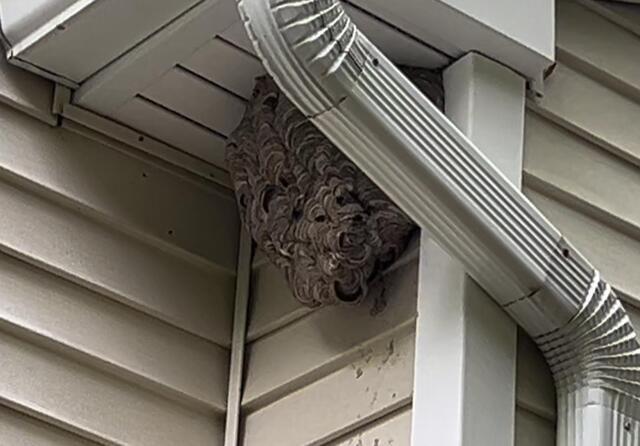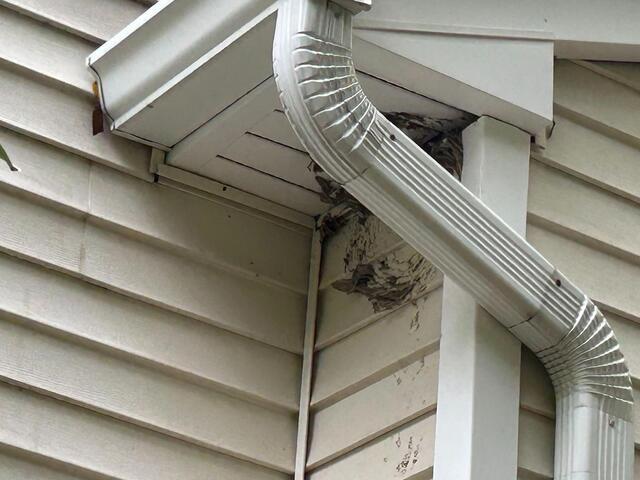Before & After Photos
Click on a photo to enlarge.
Sealing an Entry Point for Mice in Freehold, NJ
A new customer in Freehold, NJ found some mice droppings in her basement. Nervous that she might have a rodent infestation, she called our office and we were sent out to inspect and treat. When we began our inspection, we noticed that the basement was getting renovated and their were portions of the walls that were missing. We inspected one area and found a large buildup of mice droppings and an old hole that was previously used for electrical wiring. We took a closer look and found mice hair stuck in it.
For treatment, we carefully cleaned up all the droppings and installed several rodent bait stations throughout the basement and along the exterior of the home. Afterward, we stuffed the one hole, as well as several potential openings around the home, with chew-proof stainless steel mesh and then sealed them with a waterproof adhesive. Lastly, we scheduled several follow up visits to monitor the infestation and replenish the bait stations as needed.
Dirt pit crawl space get vapor barrier makeover in Perth Amboy
This homeowner in Point Pleasant Beach had one of the more unique crawl spaces that our home improvement crew has come across, and not in a good way. Without being too disparaging, this crawl space was little more than a glorified dirt pit. It was such a dusty dirty mess that it was a completely unusable space in the home. You could not even venture down there without returning to ground level looking as though you just emerged from the depths of a Kentucky coal mine.
Fortunately, this homeowner decided that enough was enough! It was time to give his crawl space a complete makeover. Cowleys is a certified Basement Systems dealer. Basement Systems pioneered the field of crawl space repair and encapsulation for moisture control and waterproofing. With their system, a chronically damp wet crawl space can be transformed into a clean, dry foundation. Unlike traditionally vented crawl spaces, encapsulation prevents water seepage and hot, humid air from entering the crawl space, as well as acting as a barrier for insects and nuisance wildlife. When supplemented by dehumidification, encapsulation inhibits dangerous mold growth and other allergens, providing clean, healthy air for the occupants residing in the home.
The Cowleys crew arrived. We first installed CleanSpace liners. Never before has the term “clean space” been more true. Before we got there you could not go down into this basement without getting filthy dirty. We installed both a 4 ft. high wall liner, and a floor liner to finish off the job. These liners are thick, tear-resistant vapor barriers that prevent moisture from passing through the floors and concrete walls.
The last step of this project was installing a maintenance-free commercial-grade SaniDry XP model dehumidifier to keep the basement free of excess humidity that can trigger dangerous mold (There is also a CX model for smaller areas). These compact dehumidifiers are specifically designed for crawl spaces and mid-sized basements. They can operate in temperatures as low as 40 degrees F. and are much more powerful than traditional dehumidifiers. Once they are set up, there’s nothing to do. They operate automatically, turning on and off according to a built-in hygrometer. Also, these machines don’t have a water tray that needs to be emptied. They connect directly into the home’s drainage system.
The homeowner was extremely happy with his new crawl space, knowing that he could now go down there or send a repair person there without returning covered in dust. Now, he could even use the space for storage. Also, with these liners secure and in place along with the dehumidifier, the crawl space will be kept dry. Without excess moisture and humidity build-up, he won’t need to worry about mold, insects, and other issues down below.
Excluding Bats in Morganville, NJ
This homeowner in Morganville, NJ had an issue with bats roaming around his attic, so our Nuisance Wildlife Division was sent out and safely removed them from the home. Now that the bats are gone, we need to make sure they don't get back in!
After a thorough examination of the home, we determined that the bats were able to enter the home via the ridge vent & the attic fan. To fix this, we installed Ridge-Guard® and an attic fan cover. Ridge-Guard® secures and reinforces the ridge vent shingles so that bats, flying squirrels, and other nuisance wildlife are unable to enter. The attic fan covers are made out of heavy-duty 18 Gauge expanded Galvannealed steel mesh and prevents all nuisance wildlife from entering the home through the attic fan. Not only is the home properly secured from bats, but all nuisance wildlife too!
Excluding the Squirrels from the Gable Vent in Morganville, NJ
This homeowner in Morganville, NJ, had an infestation of squirrels in their attic. After a thorough inspection, we discovered that they were entering the home via the gable vent. Squirrels infesting a home via the gable vents is very common as over time, the gable vents get weathered and squirrels (and other nuisance wildlife) have no problem ripping away these vents to find shelter inside a home. After installing our retrieval devices, in a short amount of time, we successfully and safely retrieved all the squirrels and relocated them to a new, humane location.
Before we left, we removed the broken gable vent, disinfected the attic, and installed a louvered vent guard. This material is made out of heavy-duty Galvannealed steel (which means it won't rust) and is customized to accommodate vents of all shapes and sizes. Now that it is installed, squirrels and other nuisance wildlife will no longer be able to enter the attic through the gable vent.
Unsuspected Homeowner Gets Stung by Bald-Faced Hornet in Morganville, NJ
As this customer in Morganville, NJ was working out in his backyard, he noticed a rather large hornets nest on the side of his home! Since he is a Home Protection Plan customer, he called up Cowleys, and we were sent out. After equipping our protective bee suits we took a closer look at these insects and identified them as bald-faced hornets. Bald-faced hornets are social stinging insects that have white markings on their face. They're EXTREMELY aggressive and territorial. So aggressive that if anyone or anything comes within close proximity of their nest, they will attack!
Using our extendable pole, we liberally treated the nest with a knockdown aerosol application and then a knockdown dusting product. Both of these treatments will exterminate the bald-faced hornets quickly. After some time had passed, we removed the nest and disposed of it properly. Lastly, we applied a liquid non-repellant residual to the area where the nest was. This will neutralize any bald-faced hornets that return to this area and prevent them, and any other stinging insect, from building a new nest.













